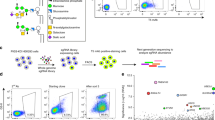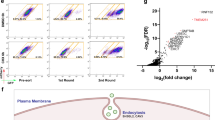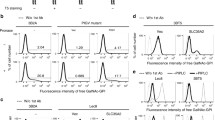Abstract
The conserved oligomeric Golgi (COG) complex is a eight subunit (COG1 to 8) tethering complex involved in the retrograde trafficking of multiple Golgi processing proteins. Here we studied the glycolipid synthesis status in ldlC cells, a Cog2 null mutant CHO cell line. Biochemical studies revealed a block in the coupling between LacCer and GM3 synthesis, resulting in decreased levels of GM3 in these cells. Uncoupling was not attributable to decreased activity of the glycosyltransferase that uses LacCer as acceptor substrate (SialT1). Rather, immunocytochemical experiments evidenced a mislocalization of SialT1 as consequence of the lack of Cog2 in these cells. Co-immunoprecipitation experiments disclose a Cog2 mediated interaction of SialT1 with the COG complex member Cog1. Results indicate that cycling of some Golgi glycolipid glycosyltransferases depends on the participation of the COG complex and that deficiencies in COG complex subunits, by altering their traffic and localization, affect glycolipid composition.





Similar content being viewed by others
References
Regina Todeschini A, Hakomori SI (2008) Functional role of glycosphingolipids and gangliosides in control of cell adhesion, motility, and growth, through glycosynaptic microdomains. Biochim Biophys Acta 1780:421–433
Maccioni HJ (2007) Glycosylation of glycolipids in the Golgi complex. J Neurochem 103(Suppl 1):81–90
Panzetta P, Gravotta D, Maccioni HJ (1987) Biosynthesis and expression of gangliosides during differentiation of chick embryo retina cells in vitro. J Neurochem 49:1763–1771
Yu RK, Macala LJ, Taki T et al (1988) Developmental changes in ganglioside composition and synthesis in embryonic rat brain. J Neurochem 50:1825–1829
Yu RK, Bieberich E, Xia T et al (2004) Regulation of ganglioside biosynthesis in the nervous system. J Lipid Res 45:783–793
Maxzud MK, Daniotti JL, Maccioni HJ (1995) Functional coupling of glycosyl transfer steps for synthesis of gangliosides in Golgi membranes from neural retina cells. J Biol Chem 270:20207–20214
Colley KJ (1997) Golgi localization of glycosyltransferases: more questions than answers. Glycobiology 7:1–13
Uliana AS, Giraudo CG, Maccioni HJ (2006) Cytoplasmic tails of SialT2 and GalNAcT impose their respective proximal and distal Golgi localization. Traffic 7:604–612
Giraudo CG, Maccioni HJ (2003) Endoplasmic reticulum export of glycosyltransferases depends on interaction of a cytoplasmic dibasic motif with Sar1. Mol Biol Cell 14:3753–3766
Quintero CA, Giraudo CG, Villareal M, Montich G, Maccioni HJ (2010) Identification of a site in Sar1 involved in the interaction with the cytoplasmic tail of glycolipid glycosyltransferases. J Biol Chem 285:30340–30346
Lippincott-Schwartz J, Yuan LC, Bonifacino JS et al (1989) Rapid redistribution of Golgi proteins into the ER in cells treated with brefeldin A: evidence for membrane cycling from Golgi to ER. Cell 56:801–813
Rhee SW, Starr T, Forsten-Williams K et al (2005) The steady-state distribution of glycosyltransferases between the Golgi apparatus and the endoplasmic reticulum is approximately 90:10. Traffic 6:978–990
Sztul E, Lupashin V (2006) Role of tethering factors in secretory membrane traffic. Am J Physiol Cell Physiol 290:C11–C26
Ungar D, Oka T, Brittle EE et al (2002) Characterization of a mammalian Golgi-localized protein complex, COG, that is required for normal Golgi morphology and function. J Cell Biol 157:405–415
Ungar D, Oka T, Vasile E et al (2005) Subunit architecture of the conserved oligomeric Golgi complex. J Biol Chem 280:32729–32735
Krieger M, Reddy P, Kozarsky K et al (1989) Analysis of the synthesis, intracellular sorting, and function of glycoproteins using a mammalian cell mutant with reversible glycosylation defects. Methods Cell Biol 32:57–84
Kingsley DM, Kozarsky KF, Segal M et al (1986) Three types of low density lipoprotein receptor-deficient mutant have pleiotropic defects in the synthesis of N-linked, O-linked, and lipid-linked carbohydrate chains. J Cell Biol 102:1576–1585
Krieger M, Brown MS, Goldstein JL (1981) Isolation of Chinese hamster cell mutants defective in the receptor-mediated endocytosis of low density lipoprotein. J Mol Biol 150:167–184
Podos SD, Reddy P, Ashkenas J et al (1994) LDLC encodes a brefeldin A-sensitive, peripheral Golgi protein required for normal Golgi function. J Cell Biol 127:679–691
Chatterton JE, Hirsch D, Schwartz JJ et al (1999) Expression cloning of LDLB, a gene essential for normal Golgi function and assembly of the ldlCp complex. Proc Natl Acad Sci USA 96:915–920
Oka T, Ungar D, Hughson FM et al (2004) The COG and COPI complexes interact to control the abundance of GEARs, a subset of Golgi integral membrane proteins. Mol Biol Cell 15:2423–2435
Giraudo CG, Maccioni HJ (2003) Ganglioside glycosyltransferases organize in distinct multienzyme complexes in CHO-K1 cells. J Biol Chem 278:40262–40271
Vasile E, Oka T, Ericsson M et al (2006) IntraGolgi distribution of the conserved oligomeric golgi (COG) complex. Exp Cell Res 312:3132–3141
Daniotti JL, Landa CA, Maccioni HJ (1994) Regulation of ganglioside composition and synthesis is different in developing chick retinal pigment epithelium and neural retina. J Neurochem 62:1131–1136
Whyte JR, Munro S (2002) Vesicle tethering complexes in membrane traffic. J Cell Sci 115:2627–2637
Ungar D, Oka T, Krieger M et al (2006) Retrograde transport on the COG railway. Trends Cell Biol 16:113–120
Smith RD, Lupashin VV (2008) Role of the conserved oligomeric Golgi (COG) complex in protein glycosylation. Carbohydr Res 343:2024–2031
Zolov SN, Lupashin VV (2005) Cog3p depletion blocks vesicle-mediated Golgi retrograde trafficking in HeLa cells. J Cell Biol 168:747–759
Shestakova A, Zolov S, Lupashin V (2006) COG complex-mediated recycling of Golgi glycosyltransferases is essential for normal protein glycosylation. Traffic 7:191–204
Giraudo CG, Daniotti JL, Maccioni HJ (2001) Physical and functional association of glycolipid N-acetyl-galactosaminyl and galactosyl transferases in the Golgi apparatus. Proc Natl Acad Sci USA 98:1625–1630
Uliana AS, Crespo PM, Martina JA et al (2006) Modulation of GalT1 and SialT1 sub-Golgi localization by SialT2 expression reveals an organellar level of glycolipid synthesis control. J Biol Chem 281:32852–32860
Wu X, Steet RA, Bohorov O et al (2004) Mutation of the COG complex subunit gene COG7 causes a lethal congenital disorder. Nat Med 10:518–523
Foulquier F, Ungar D, Reynders E et al (2007) A new inborn error of glycosylation due to a Cog8 deficiency reveals a critical role for the Cog1-Cog8 interaction in COG complex formation. Hum Mol Genet 16:717–730
Reynders E, Foulquier F, Leao Teles E et al (2009) Golgi function and dysfunction in the first COG4-deficient CDG type II patient. Hum Mol Genet 18:3244–3256
Zeevaert R, Foulquier F, Cheillan D et al (2009) A new mutation in COG7 extends the spectrum of COG subunit deficiencies. Eur J Med Genet 52:303–305
Paesold-Burda P, Maag C, Troxler H et al (2009) Deficiency in COG5 causes a moderate form of congenital disorders of glycosylation. Hum Mol Genet 18:4350–4356
Acknowledgments
This work was supported in part by Grants from Secretaría de Ciencia y Tecnología, Universidad Nacional de Córdoba, Argentina, Agencia Nacional de Promoción Científica y Tecnológica, Argentina and Ministerio de Ciencia y Tecnología de la Provincia de Córdoba. The technical assistance of G. Schachner and S. Deza with cell cultures and of M. C. Sampedro with confocal microscopy is also acknowledged. H. J. F. M. is a Career Investigator of CONICET (Argentina).
Author information
Authors and Affiliations
Corresponding author
Additional information
This work is dedicated to Dr. Abel L. Lajtha on occasion of his retirement as Editor-in-Chief of Neurochemical Research, of which he was founder and which he continuously improved during the last 35 years. In addition to his solid scientific work and his decisive contribution to the development of Neurochemistry, his kind personality has made very pleasant the time I spent as Member of the Editorial Board.
Rights and permissions
About this article
Cite this article
Spessott, W., Uliana, A. & Maccioni, H.J.F. Defective GM3 Synthesis in Cog2 Null Mutant CHO Cells Associates to Mislocalization of Lactosylceramide Sialyltransferase in the Golgi Complex. Neurochem Res 35, 2161–2167 (2010). https://doi.org/10.1007/s11064-010-0319-8
Accepted:
Published:
Issue Date:
DOI: https://doi.org/10.1007/s11064-010-0319-8




